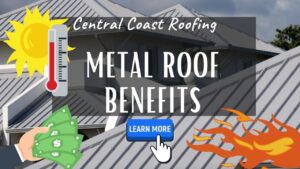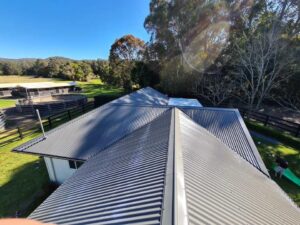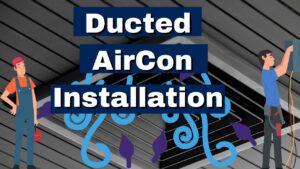Metal Roofing System
Metal roofing systems are recognized for their resistance, imperviousness, and durability.
There are several materials to choose from when building a new roof or replacing an old one. Regardless of the type of roof you have, metal roofing is low maintenance and energy efficient option.
Types Of Metal Roofing Materials
In the world of roofing, metal roofs are the Cadillac. Depending on the maker, this comparison may not be flattering.
In actuality, a metal roof refers to a variety of items.
The name itself doesn’t specify whether it’s a steel, aluminum, zinc, or copper roof.
Metal roofing comes in five different forms:
1. Copper
2. Aluminium
3. Zinc
4. Steel – three variants: galvanized, Galvalume, and weatherproof steel (Corten)
5. Tin
Copper Roofing
Copper is not just a durable metal that may endure well over 200 years under optimum conditions.
For builders interested in reusing the resources they utilize.
Additionally, copper roofs are 100 percent recyclable, making them an excellent choice for green or eco-inspired roofs.
Copper is a costly material at the moment, and it is seldom used for roofing, except when it is part of an architectural design that includes the roof as a highlight.
Copper is an extremely soft metal, making it one of the most silent metal roofing materials available.
Due to contemporary installation techniques, all-metal roofs require a sufficient foundation and insulation to minimize noise from rain or hail.
Regrettably, the softer nature of copper roofing means that it is susceptible to damage in areas prone to hail.
Copper is a softer metal, and hailstones may readily damage it.
Aluminium Roofing
Aluminum metal roofing is frequently recommended for coastal climates. This is because aluminum is more resistant to salt corrosion than other metal roofs. While it is a popular misconception that aluminum roofs are impervious to pollution, aluminum is a highly reactive metal that reacts nearly quickly to the elements. Additionally, it is more costly than comparable techniques that employ aluminum as a coating, giving superior corrosion protection.
Zinc Roofing
Zinc is an amazing metal that can mend scratches over time and maintain its patina for more than 100 years. Additionally, zinc’s inherent characteristics make it a popular choice for commercial projects since it can be easily shaped and molded into unusual designs.
On the other hand, zinc is a rather soft metal that may be easily damaged by hail or strong winds, depending on the form of the panels or shingles.
Steel Roofing
Steel is a metal alloy composed primarily of iron and other elements.
Numerous building projects make exclusive use of steel roofing.
It is a frequently utilized material on commercial construction sites and is increasingly employed in home construction.
Steel is also the least costly metal when compared to other metals. While steel is a commodity, its price is frequently significantly lower than aluminum, zinc, or copper. As a result, steel is more affordable and more abundant than the other metals on this list.
Tin Roofing
Aluminum as a construction material became obsolete when aluminum became the standard for containers and tin roofs were phased out. As a result, when people speak to “tin roofs” in current times, they typically refer to galvanized steel or aluminum rather than the real tin roof.
While tin has various applications in science and engineering, it is no longer widely utilized as a building material, and tin roofing sheets have been mostly phased out.
Is It Worth Having A Metal Roof?
Yes, the solution to this question is rather straightforward.
When choosing a new roof, you must examine the material that will be used. While roofs come in a variety of forms and sizes, consider the advantages of a metal roof. Metal roofs have several advantages, including the following:
Durability: Depending on the material, metal roofs can last between 40 and 70 years.
Durability: When constructed properly, certain metal roofs can endure wind gusts of up to 140 miles per hour, are impervious to corrosion and cracking, and are impact-resistant (depending on the product chosen). Additionally, unlike other roofing materials, metal roofs do not require the same level of regular and costly maintenance as other roofing materials.
Metal roofs cannot catch fire or explode into flames in a forest fire or lightning strike.
Metal roofs reflect the sun’s ultraviolet and infrared rays, resulting in the radiant heat from the roof surface, which can cut cooling expenses by 10% to 25%.
Not only are metal roofs environmentally friendly, but they also include a recycled component of 25-95 percent, depending on the material used. Additionally, they are 100 percent recyclable once no longer required as a roof. In comparison, most shingle waste — up to 20 billion pounds per year – ends up in residential trash.
What Makes A Metal Roof Better Than A Tile Roof?
In cold climates, metal roofing vs. tile roofing
If you live in a region with low temperatures, comfort, and energy savings are essential, especially during the winter. Tile or shingles absorb and transfer heat from the sun to the interior of your home. As a result, your heating system will work less hard to maintain a pleasant temperature in your house, and you’ll save money on your power bills.
Generally, though, a metal roof will keep your living area warmer than asphalt shingles. Because metal is a natural conductor of heat, it can readily collect sunlight and convert it to heat that will help keep your home warm in the winter. Additionally, the sheathing beneath this roofing material is insulating, which helps keep absorbed heat in check. As a result, metal roofs can absorb heat and endure snow and ice without succumbing to moisture damage.
Metal roofs are lightweight and durable.
Metal roofs are significantly lighter than concrete tiles. However, their bulk does not detract from their strength. For example, the Gerard pressed steel roofing system weighs approximately 10 times less than a comparable concrete tile roofing system.
Even the most basic metal roofs are extremely lightweight, which means that if you’re building a new home, your new roof may even save you money on support structure expenses.
Metal roofing is simple to install.
Metal roofing is available in size standing seam sheets or portions with numerous shingles ranging in width from 12 to 36 inches. Standing seam sheets are typically three feet wide and six, eight, ten, twelve, or fourteen feet long. Additionally, custom sizes are available.
An expert contractor may rapidly install them. Adding a day or two to the installation procedure might be critical if your roof collapses and a storm is approaching. Of course, you may also save significant money by simplifying and shortening the roof installation process.
Metal roofs are non-combustible.
Because metal roofs are non-combustible, they generally have a Class A fire rating (the highest). As a result, they cannot be ignited by flying sparks or embers.
Bear in mind, however, that the materials determine a portion of a roof’s total rating beneath the surface, which may potentially catch fire if exposed to extreme heat.
Heat is reflected off metal surfaces.
Metal reflects solar radiation, therefore decreasing midday heat. This reflecting feature enables you to save money on daytime air conditioning.
Regarding the insulation value of metal roofs in hot and cold climates, while the material itself has a low R-value, metal roofs may be placed atop very high-R-value foam insulation.
Metal keeps snow and rain well.
Because of the panels’ interlock and the rough and slippery surfaces, metal roofs are very impervious to rain and snow. Additionally, the dark colors of metal roofs absorb heat from the sun, promoting snowmelt.
Additionally, the calming sound of rain on a tin roof may be heard in both white-noise devices and meditation applications.
Of course, this is not the sole (or even the primary!) reason for its appeal among today’s homeowners. Metal roofs are increasingly being used in new construction and roof replacements.
How do you pick the correct metal panel color?
With so many various colors and finishes available for metal roofing, siding, and accent panels, it can be difficult to pick the right color for your project.
Whether you’re looking for a modern, industrial, rustic, contemporary, or other aesthetic, the color you pick will be critical in attaining your intended aesthetic. The following information will assist you in selecting the appropriate color for your next project.
1. Determine your style
2. Choose a few color options
3. Order a few samples
4. Make a final decision
Contact one of the experts at awsroofing.com immediately if you’re ready to take the next step with your metal roofing project. The team at AWS Roofing can help you install the best metal roof possible.
AWS Roofing
26 Elizabeth Bay Dr
Lake Munmorah NSW 2259
0407 133 435
The Article Metal Roofing Benefits And Why It Is Better Than A Tile Roof First Appeared ON
: https://clubtheo.com
The Article Metal Roofing Benefits And Why It Is Better Than A Tile Roof First Appeared ON
: https://gqcentral.co.uk
The post Metal Roofing Benefits And Why It Is Better Than A Tile Roof appeared first on https://alef3.com








Comments are closed